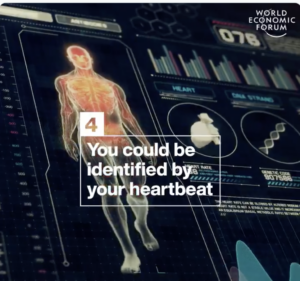
The World Economic Forum (WEF), the ultimate global-elite program owned and run by Evil Villain and nudist, Klaus Schwab, has predicted that countries will begin tracking people by their heartbeats as wearing masks during the Chinese coronavirus pandemic has made facial surveillance more difficult. The NASA-developed ‘Heartbeat ID‘ claims to be a “new biometric technique to verify someone’s identity. It can be used in everything from replacing an individuals PC passwords to access a bank account.”
Everyone’s heart is different. Like the iris or fingerprint, our unique cardiac signature can be used as a way to tell us apart. Crucially, it can be done from a distance.
It’s that last point that has intrigued US Special Forces and totalitarian regimes everywhere. Other long-range biometric techniques include gait analysis, which identifies someone by the way he or she walks. This method was supposedly used to identify an infamous ISIS terrorist before a drone strike. But gaits, like faces, are not necessarily distinctive. An individual’s cardiac signature is unique, though, and unlike faces or gait, it remains constant and cannot be altered or disguised.
Long-range detection
A new device, developed for the Pentagon after US Special Forces requested it, can identify people without seeing their face: instead it detects their unique cardiac signature with an infrared laser. While it works at 200 meters (219 yards), longer distances could be possible with a better laser. “I don’t want to say you could do it from space,” says Steward Remaly, of the Pentagon’s Combatting Terrorism Technical Support Office, “but longer ranges should be possible.”
HeartBeatIDPatent Only, No Software Available For License.One or more biometric indicia, such as fingerprints, voice-prints, retinal scans, and facial features are often proposed to be used to identify, or to authenticate the asserted identity of a user who seeks access to a given resource. This invention provides a method and associated system for authenticating or declining to authenticate an identity asserted by a candidate person. The heartbeat system is a new biometric technique to verify someone’s identity. It can be used in everything from replacing an individuals PC passwords to access a bank account.Benefits
- Physiological parameters
- Living biometric characteristics
- Accuracy and precision
- Ability to identify if a subject is already in the database
- Friendly Graphical User Interface
- High speed due to C++ code
- Portability to mobile platforms
- Highly secure High universality
- High Uniqueness
Applications
- Identity Verification
- Justice/Law Enforcement
- Mobile Biometrics
- Banks and financial institutions
- Network Login Solution
- PC/Laptop Security
- Time and Attendance
- Healthcare Biometric
- Logical Access Control
- E-commerce and Web Applications
- Homeland Security / Airports / National ID Documents
The Technology
Cardiac muscle is myogenic and is capable of generating an action potential and depolarizing and repolarizing signals from within the muscle itself. An intrinsic conduction system (ICS), a group of specialized cardiac cells, passes an electrical signal throughout the heart. This technology is a method and associated system to identify a person based on the use of statistical parameters, peak amplitudes and/or time interval lengths and/or depolarization-repolarization vector angles and/or depolarization-repolarization vector lengths for PQRST electrical signals associated with heart waves. The statistical parameters, estimated to be at least 192, serve as biometric indicia to authenticate or to decline to authenticate an asserted identity of a candidate person. There are three on-line modes of operation enrollment, verification, and identification as well as two off-line modes statistics and settings. In enrollment the raw electrocardiography (ECG) signal is processed and the results in the form of parameters are serialized and saved. Verification and Identification procedures use the feature parameters for recognition (classification) of subjects based on the same kind of parameters (features) of heartbeats extracted from the ECG signal of a person to be verified or identified.
Download a PDF fact sheet for this technology.
